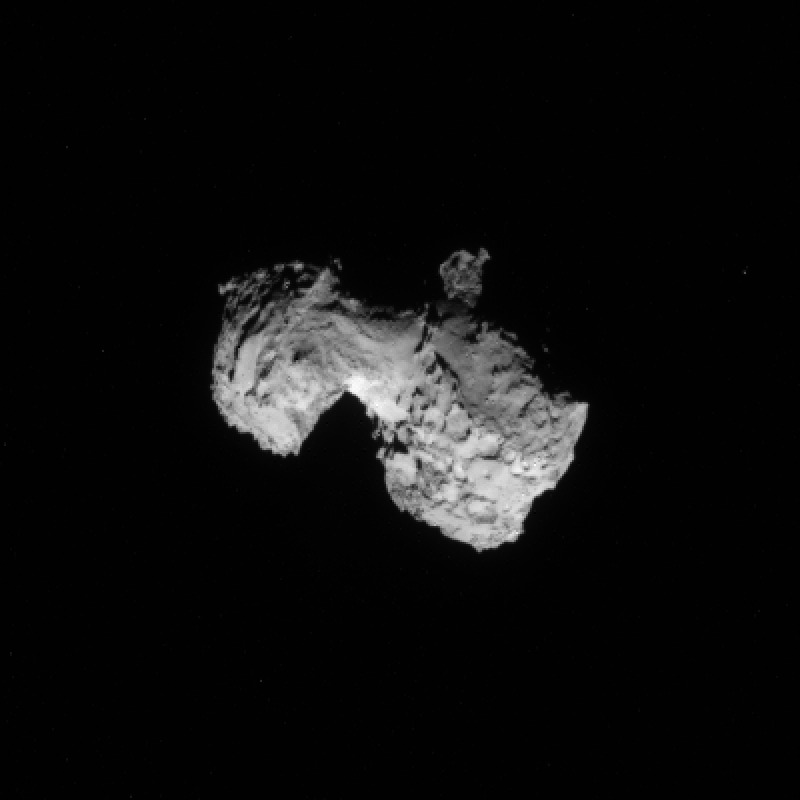It looks like you're using an Ad Blocker.
Please white-list or disable AboveTopSecret.com in your ad-blocking tool.
Thank you.
Some features of ATS will be disabled while you continue to use an ad-blocker.
Rosetta update: comet Churyumov-Gerasimenko is a rubber duckie! (more precisely, a contact binary)
page: 110
share:
As Rosetta approached its
target comet, the shape of the nucleus was revealed to be a contact binary
-- two unequal-sized objects in contact with each other:
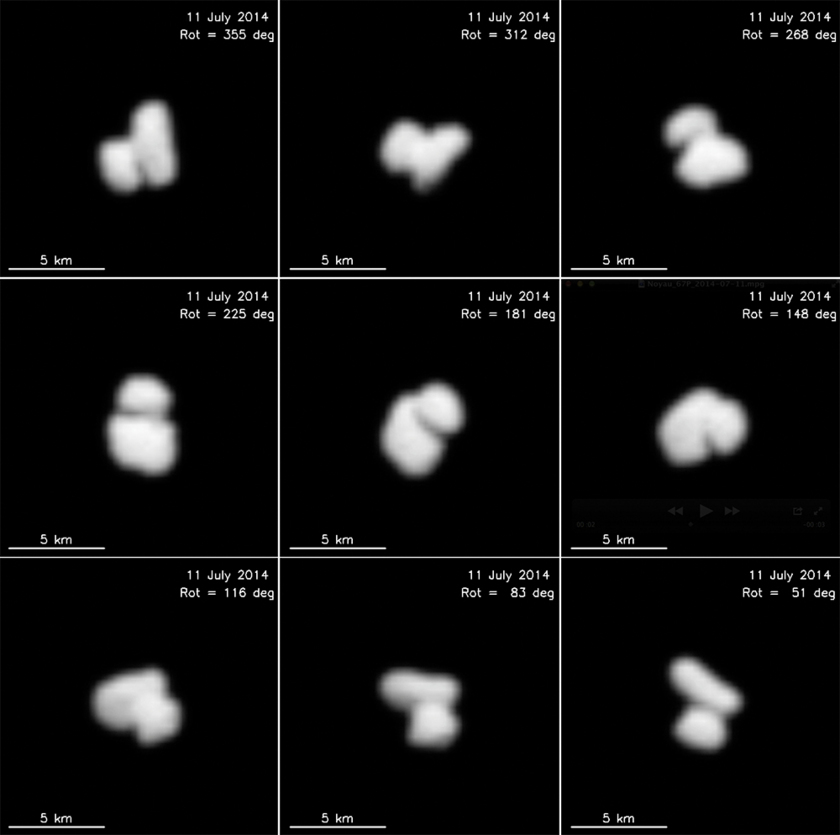
The whole nucleus measures 4 by 3.5 kilometers, in good agreement with Hubble and Spitzer estimates. It is estimated that the two components would have come into contact at a relative speed of about 3 meters per second in order to stick together in this way.
This unusual shape could present a navigational challenge for the Philae lander team. The Philae navigator Eric Jurado says that "navigation around such a body should not be much more complex than around a nucleus of irregular spherical type, but landing the Philae probe [scheduled for November 11], however, could be more difficult, as this form restricts potential landing zones."
www.planetary.org...
That's one funky comet! I'm very much looking forward to the close-up images by Rosetta. Trying to land a probe on such a body is a problem indeed.

The whole nucleus measures 4 by 3.5 kilometers, in good agreement with Hubble and Spitzer estimates. It is estimated that the two components would have come into contact at a relative speed of about 3 meters per second in order to stick together in this way.
This unusual shape could present a navigational challenge for the Philae lander team. The Philae navigator Eric Jurado says that "navigation around such a body should not be much more complex than around a nucleus of irregular spherical type, but landing the Philae probe [scheduled for November 11], however, could be more difficult, as this form restricts potential landing zones."
www.planetary.org...
That's one funky comet! I'm very much looking forward to the close-up images by Rosetta. Trying to land a probe on such a body is a problem indeed.
edit on 15-7-2014 by wildespace because: (no reason given)
A rubber duckey is right.
Or at least it would have been debunked as such if it were on youtube.
Or at least it would have been debunked as such if it were on youtube.
So I have a question. With this new data is it possible for the Comet to split as it approaches our Sun? It seems close enough to me. That could be
cool.
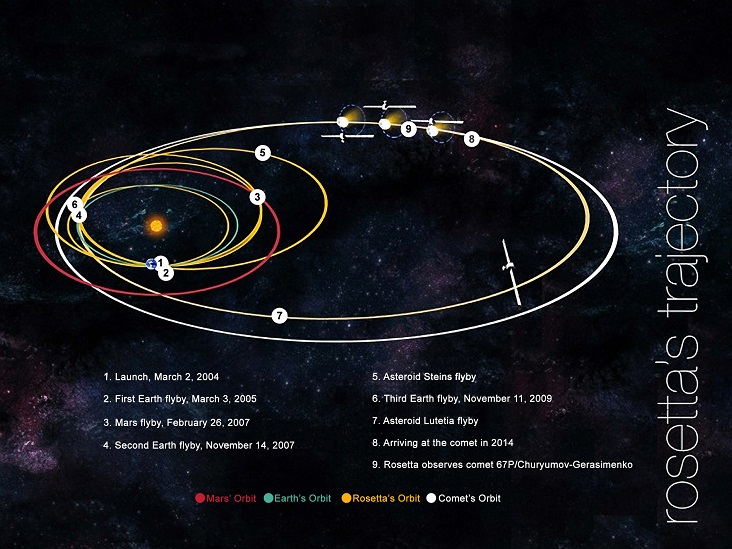

I could easily land on that...
I hope I get reincarnated as a bad ass inter-planetary fighter pilot...
I hope I get reincarnated as a bad ass inter-planetary fighter pilot...
a reply to: OccamsRazor04
if they are two distinct bodies, then there may be pockets of gas caught between them. or ice.
as it approaches the sun, it will heat and this gas/ice can expand to steam with explosive force.
look at shoemaker-levy 9
if they are two distinct bodies, then there may be pockets of gas caught between them. or ice.
as it approaches the sun, it will heat and this gas/ice can expand to steam with explosive force.
look at shoemaker-levy 9
originally posted by: okamitengu
a reply to: OccamsRazor04
if they are two distinct bodies, then there may be pockets of gas caught between them. or ice.
as it approaches the sun, it will heat and this gas/ice can expand to steam with explosive force.
look at shoemaker-levy 9
Shoemaker levy fragments traveled in the same path until colliding with Jupiter. It also was not orbiting the Sun at all.
a reply to: OccamsRazor04
In a comet breakup, while the resulting fragments continue on the same general trajectory, the force that dislodged them will send them slowly moving away from each other.
I have no idea about the possibility of this particular comet's breakup (I shall ask around on the astronomy groups and forums), but it would be quite somethig to observe, especially if Rosetta is still there nearby.
~~~
P.S. what I actually came here for, is to post this cool animation of the Rosetta images:

Source: blogs.esa.int...
In a comet breakup, while the resulting fragments continue on the same general trajectory, the force that dislodged them will send them slowly moving away from each other.
I have no idea about the possibility of this particular comet's breakup (I shall ask around on the astronomy groups and forums), but it would be quite somethig to observe, especially if Rosetta is still there nearby.
~~~
P.S. what I actually came here for, is to post this cool animation of the Rosetta images:

Source: blogs.esa.int...
edit on 17-7-2014 by wildespace because: (no reason
given)
originally posted by: OccamsRazor04
a reply to: howmuch4another
They are going in the same direction how would they split?
I'm not an expert that's why I asked but a guess would be the ice connecting the masses melts or like OK said gasses expanding rapidly. Add to that the centrifugal force that Wilds animation shows and I would think it possible. I think it's really interesting.
Some estimated facts about the comet:
It's overall density is very low, 102 kg/m3, somewhere between the density of cork and styrofoam. I think this means that there are a lot of voids filled with gas or vacuum. The heating and expansion of this gas could mean the comet might disintegrate. (but let's wait for estimates)
It's escape velocity is just 0.46 m/s, meaning if you jumped hard enough, you would leave the nucleus and not fall back to it. I think that that's the minimum velocity the fragments have to be pushed from each other for the comet to truly come apart.
It's overall density is very low, 102 kg/m3, somewhere between the density of cork and styrofoam. I think this means that there are a lot of voids filled with gas or vacuum. The heating and expansion of this gas could mean the comet might disintegrate. (but let's wait for estimates)
It's escape velocity is just 0.46 m/s, meaning if you jumped hard enough, you would leave the nucleus and not fall back to it. I think that that's the minimum velocity the fragments have to be pushed from each other for the comet to truly come apart.
Latest image from Rosetta, and it looks great! Finally, the "rubber duckie" comet in good resolution:
blogs.esa.int...
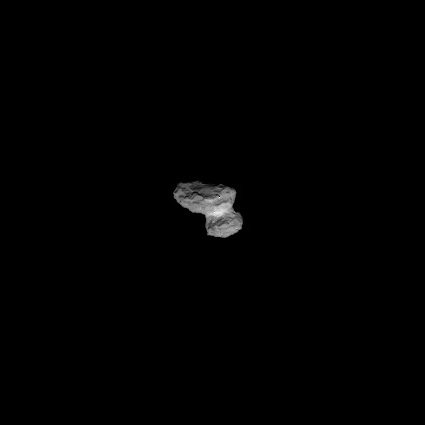
Enlaged image: www.esa.int...
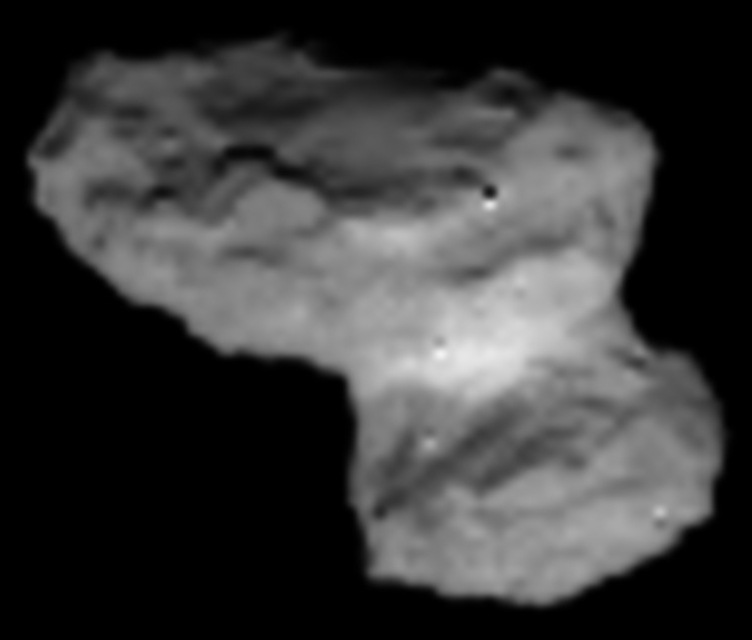
Also breaking news: Rosetta measured the comet's overall temperature, and it seems to be on the warm side, suggesting that the comet is almost completely covered in dark dust: www.esa.int...

Enlaged image: www.esa.int...

Also breaking news: Rosetta measured the comet's overall temperature, and it seems to be on the warm side, suggesting that the comet is almost completely covered in dark dust: www.esa.int...
Since quite early images of this comet's nucleus, and persisting through the latest one, I've had the impression that the two lobes are both rather
boxy shaped, with some straight edges on one aligned with those on the other. I've looked at a number of images of the nuclei of other comets, but
seen nothing similar to this.
The typical comet nucleus appears to be shaped something like a potato, with all the variability that this implies; some elongated, some more nearly spherical, but preserving the same sort of general roundedness.
I've been trying to imagine an astrophysical scenario that would produce a comet of roughly rectilinear shape, without much success.
The typical comet nucleus appears to be shaped something like a potato, with all the variability that this implies; some elongated, some more nearly spherical, but preserving the same sort of general roundedness.
I've been trying to imagine an astrophysical scenario that would produce a comet of roughly rectilinear shape, without much success.
The low density of this comet has been remarked upon. It is only about 11% as dense as water ice, as against around 60 percent for other comets. Even
if we were to disregard the effects of denser materials such as rock and dust, on the whole body density, this means that this comet's interior is
made up of at least 89 % essentially empty spaces of one sort or another. This odd, low density may explain why this particular comet happened to be
selected for on-site examination by the Rosetta spacecraft.
a reply to: eriktheawful
It's a great picture. There are some very bright (or reflective) areas seen in the recent images. I hope these are patches of ice.
I's been exciting to watch the comet getting closer each day, revealing more detail on the surface. ESA Rosetta blog
By the way, Rosetta's arival and orbital insertion to the comet is tomorrow! The comet's tiny mass means that Rosetta will be able to orbit it any way the mission contol likes, including some funky maneuvers: www.youtube.com...
It's a great picture. There are some very bright (or reflective) areas seen in the recent images. I hope these are patches of ice.
I's been exciting to watch the comet getting closer each day, revealing more detail on the surface. ESA Rosetta blog
By the way, Rosetta's arival and orbital insertion to the comet is tomorrow! The comet's tiny mass means that Rosetta will be able to orbit it any way the mission contol likes, including some funky maneuvers: www.youtube.com...
edit on 5-8-2014 by wildespace because: (no reason given)
The appearance of the comet is remarkable, so unlike the rounded, 'potato-shaped' comet nuclei we have seen before. The latest image from the Rosetta
spacecraft, now in orbit of the object, reveals two blocky lobes, connected by a rather narrow 'neck' of somewhat sinuous appearance.
On the smaller of the two lobes, and opposite this connection, is a large crater, about half the diameter of this lobe. Given the low density and apparent fragility of the object, it's hard to understand how it survived this impact, intact. Link to article with latest image of the comet, below:
news.sciencemag.org...
On the smaller of the two lobes, and opposite this connection, is a large crater, about half the diameter of this lobe. Given the low density and apparent fragility of the object, it's hard to understand how it survived this impact, intact. Link to article with latest image of the comet, below:
news.sciencemag.org...
edit on 6-8-2014 by Ross 54
because: added link address
edit on 6-8-2014 by Ross 54 because: improved paragraph structure.
originally posted by: Ross 54
The appearance of the comet is remarkable, so unlike the rounded, 'potato-shaped' comet nuclei we have seen before. The latest image from the Rosetta spacecraft, now in orbit of the object, reveals two blocky lobes, connected by a rather narrow 'neck' of somewhat sinuous appearance.
On the smaller of the two lobes, and opposite this connection, is a large crater, about half the diameter of this lobe. Given the low density and apparent fragility of the object, it's hard to understand how it survived this impact, intact. Link to article with latest image of the comet, below:
news.sciencemag.org...
What if this is not a crater, but a site of massive outgassing? Or perhaps it's a crater left by just as fragile body as the comet itself.
Those are both possibilities. Outgassing over a large, highly circular area seems unlikely, though. Melting of subsurface ice and the resultant
expulsion of gas is likely to be pretty random. We already know that impacts consistently produce round craters.
As 67 P Churyumov-Gerasimenko is apparently unusually low in density, even for a comet, it seems unlikely that it would encounter another object of similar makeup, from out of the depths of space. The same goes for the suggestion that the object's two-lobed structure was caused by the contact of two similarly constituted objects.
As 67 P Churyumov-Gerasimenko is apparently unusually low in density, even for a comet, it seems unlikely that it would encounter another object of similar makeup, from out of the depths of space. The same goes for the suggestion that the object's two-lobed structure was caused by the contact of two similarly constituted objects.
A more recent image, linked below, shows the same area of the comet, from a somewhat different angle. The putative large crater is shown from a much
better viewing angle. We see inward sloping walls, from all around the surrounding, elevated terrain, and possible debris piles resting at the bottom
of the slopes on the floor of the supposed crater, most conspicuously at about the 4 o'clock position. There also appear to be two fairly distinct
dark linear features, which appear to extend across the putative crater.
www.esa.int...
www.esa.int...
edit on 10-8-2014 by Ross 54 because: (no reason
given)
edit on 10-8-2014 by Ross 54 because: corrected link address
edit on 10-8-2014 by Ross 54 because: corrected
link address
new topics
-
Australian PM says the quiet part out loud - "free speech is a threat to democratic dicourse"...?!
New World Order: 42 minutes ago -
Ireland VS Globalists
Social Issues and Civil Unrest: 1 hours ago -
Biden "Happy To Debate Trump"
Mainstream News: 1 hours ago -
RAAF airbase in Roswell, New Mexico is on fire
Aliens and UFOs: 1 hours ago -
What is the white pill?
Philosophy and Metaphysics: 3 hours ago -
Mike Pinder The Moody Blues R.I.P.
Music: 4 hours ago -
Putin, Russia and the Great Architects of the Universe
ATS Skunk Works: 7 hours ago -
A Warning to America: 25 Ways the US is Being Destroyed
New World Order: 11 hours ago
top topics
-
President BIDEN's FBI Raided Donald Trump's Florida Home for OBAMA-NORTH KOREA Documents.
Political Conspiracies: 17 hours ago, 35 flags -
A Warning to America: 25 Ways the US is Being Destroyed
New World Order: 11 hours ago, 20 flags -
Mike Pinder The Moody Blues R.I.P.
Music: 4 hours ago, 7 flags -
What is the white pill?
Philosophy and Metaphysics: 3 hours ago, 5 flags -
Biden "Happy To Debate Trump"
Mainstream News: 1 hours ago, 5 flags -
RAAF airbase in Roswell, New Mexico is on fire
Aliens and UFOs: 1 hours ago, 4 flags -
Australian PM says the quiet part out loud - "free speech is a threat to democratic dicourse"...?!
New World Order: 42 minutes ago, 4 flags -
Putin, Russia and the Great Architects of the Universe
ATS Skunk Works: 7 hours ago, 3 flags -
Ireland VS Globalists
Social Issues and Civil Unrest: 1 hours ago, 2 flags
active topics
-
Biden "Happy To Debate Trump"
Mainstream News • 25 • : LSU2018 -
Supreme Court Oral Arguments 4.25.2024 - Are PRESIDENTS IMMUNE From Later Being Prosecuted.
Above Politics • 96 • : xuenchen -
Ireland VS Globalists
Social Issues and Civil Unrest • 6 • : TimBurr -
-@TH3WH17ERABB17- -Q- ---TIME TO SHOW THE WORLD--- -Part- --44--
Dissecting Disinformation • 695 • : Thoughtful3 -
President BIDEN's FBI Raided Donald Trump's Florida Home for OBAMA-NORTH KOREA Documents.
Political Conspiracies • 32 • : network dude -
Massachusetts Drag Queen Leads Young Kids in Free Palestine Chant
Social Issues and Civil Unrest • 20 • : Oldcarpy2 -
Australian PM says the quiet part out loud - "free speech is a threat to democratic dicourse"...?!
New World Order • 2 • : ColeYounger2 -
Starburst galaxy M82 - Webb Vs Hubble
Space Exploration • 10 • : LSU2018 -
Putin, Russia and the Great Architects of the Universe
ATS Skunk Works • 24 • : Oldcarpy2 -
Gaza Terrorists Attack US Humanitarian Pier During Construction
Middle East Issues • 81 • : KrustyKrab
10

